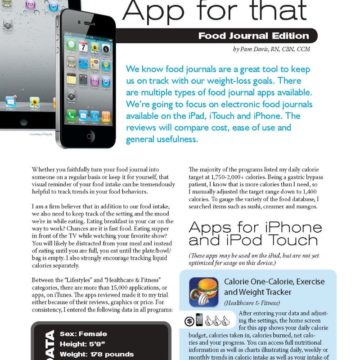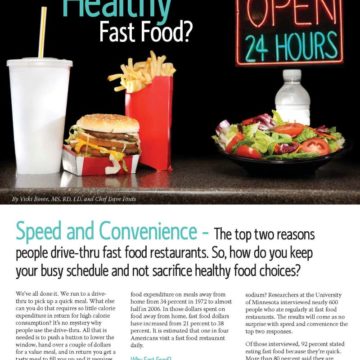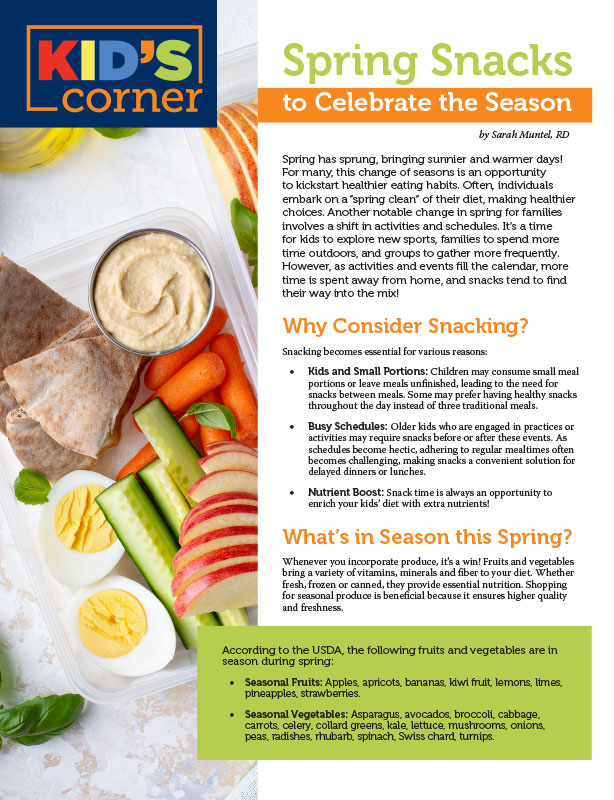Eating Out vs. Eating at Home

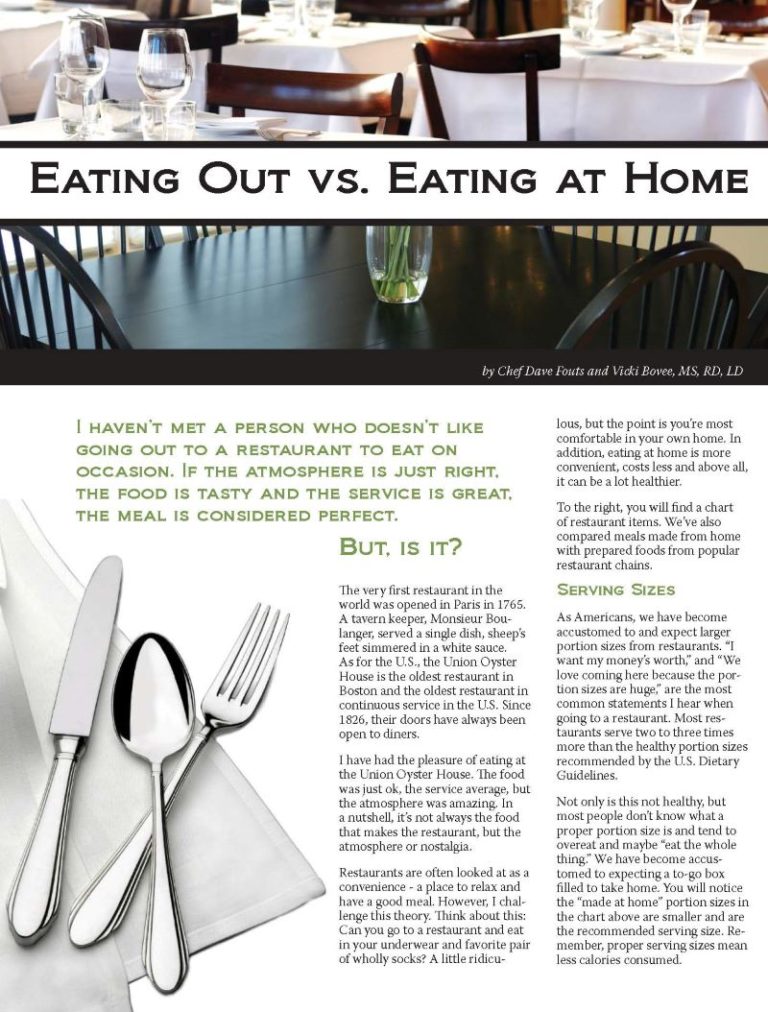
by Chef Dave Fouts and Vicki Bovee, MS, RD, LD
Fall 2010
I haven’t met a person who doesn’t like going out to a restaurant to eat on occasion. If the atmosphere is just right, the food is tasty and the service is great, the meal is considered perfect. But, is it?
The very first restaurant in the world opened in Paris in 1765. A tavern keeper, Monsieur Boulanger, served a single dish: sheep’s feet simmered in a white sauce. As for the U.S., the Union Oyster House is the oldest restaurant in Boston as well as the oldest restaurant in continuous service. Since 1826, their doors have always been open to diners.
I have had the pleasure of eating at the Union Oyster House. The food was just ok, the service average, but the atmosphere was amazing. In a nutshell, it’s not always the food that makes the restaurant, but the atmosphere or nostalgia.
Restaurants are often looked at as a convenience — a place to relax and have a good meal. However, I challenge this theory. Think about this: can you go to a restaurant and eat in your underwear and favorite pair of woolly socks? A little ridiculous, but the point is that you’re most comfortable in your own home. In addition, eating at home is more convenient, costs less and above all, it can be a lot healthier.
Below, you will find a chart of restaurant items. We’ve also compared meals made from home with prepared foods from popular restaurant chains.
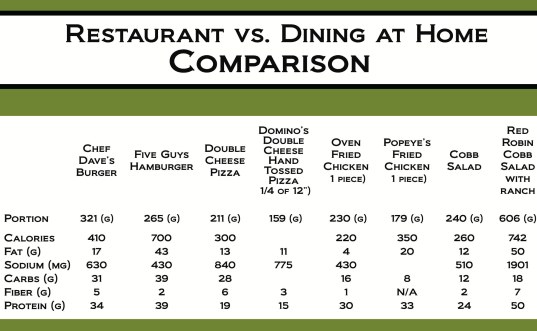 |
Serving Sizes
As Americans, we have become accustomed to and expect larger portion sizes from restaurants. “I want my money’s worth,” and “We love coming here because the portion sizes are huge,” are the most common statements I hear when going to a restaurant. Most restaurants serve two to three times more than the healthy portion sizes recommended by the U.S. Dietary Guidelines.
Not only is this not healthy, but most people don’t know what a proper portion size is. They tend to overeat and maybe “eat the whole thing.” We have become accustomed to expecting a filled to-go box to take home. You will notice the “made at home” portion sizes in the chart above are smaller and are the recommended serving size. Remember, proper serving sizes mean less calories consumed.
Savor the Flavor
Restaurants are in business to make money, and calorie-counting is not at the top of their list. Large chain restaurants have corporate chefs whose sole responsibility is to create mouth-watering, can’t-put-down food. Calories, fat, carbohydrates and many other nutrient values that are recommended are typically lost in the sea of making the tastiest dish with little regard for nutrition.
Two fried chicken patties used as a bun with cheese and mayo stuffed in the middle is being sold in a major chicken chain. Another chain sells an awesome Asian salad as far as taste goes, but with its toppings and salad dressing, it has more than 800 calories.
At a restaurant, you have almost no control over how most items are prepared, leaving your health and wellness in the hands of the chef in the back. At home, you control how much salt is being used, what fat you use to cook with, the quality of the food product and most of all, you’re in control of your health and wellness.
Time Saving
“Eating at a restaurant saves me time,” is far from the truth. The average person does not want to spend more than 20 minutes to prepare a meal for their family. Choose a recipe or food item that requires the amount of time you have to spend in the kitchen.
Plan ahead for days when you have kids’ soccer practice and you know a meal needs to be quick and nutritious (such as chicken Caesar salad). Then, on the days where life gives you more time, plan a pot roast with veggies where the prep time is 15 minutes and the cook time is three hours. As for the restaurant being quicker… if getting in the car and driving to the restaurant, waiting to be seated, waiting to order your food, waiting to get your food, paying for your meal and then driving home is quicker, then you might want to try a different recipe.
Take Responsibility
When all is said and done, you must take responsibility for your own health and wellness. Restaurants provide a great service, but in the end, you need to make decisions based on where you are in your weight management goals.
The Healthier Comparison Recipes
Well Seasoned Chef Dave Hamburger
Yields: 1
Ingredients:
- 5 ounce raw 90/10 ground beef
- ¼ teaspoon garlic powder
- ¼ teaspoon onion powder
- ¼ teaspoon chili powder
- ¼ teaspoon Worcestershire sauce
- Pinch of salt
- Pinch of black pepper
- Whole wheat hamburger bun
- 1 slice tomato
- 1 slice onion
- 1 teaspoon ketchup
- ½ teaspoon mustard
- 2 slices pickle
Directions:
- Place ground beef and spices into a small bowl and mix well.
- Form into a 5-inch patty.
- Sauté, bake or grill until hamburger is cooked to desired done-ness.
- Place beef patty onto whole wheat bun and top with lettuce, tomato, onion and condiments.
- Serve.
Double Cheese Pizza
Yields: 1
Ingredients:
- One 6-inch whole wheat pita bread
- ½ cup prepared pizza sauce (I like low-sodium spaghetti sauce)
- ¼ cup part skim Mozzarella cheese
- ¼ cup low-fat Monterrey Jack cheese
Directions:
- Preheat oven to 350 degrees.
- Bake for 12 minutes or until cheese is lightly browned.
Oven Fried Chicken
Yield: 6
Ingredients:
- Light vegetable oil cooking spray
- 6 whole chicken breasts, halved with skin removed
- 3 ½ cups ice water
- 1 cup plain nonfat yogurt
For the Breading:
- 1 cup dried Italian bread crumbs
- 1 cup all-purpose flour
- 1 tablespoon Old Bay seasoning
- ½ teaspoon garlic powder
- ¼ teaspoon freshly ground black pepper
- Dash cayenne pepper
- ½ teaspoon dried thyme
- ½ teaspoon dried basil
- ½ teaspoon dried oregano
Directions:
- Preheat oven to 400 degrees.
- Coat a baking sheet with three sprays of vegetable oil.
- Put chicken in a large bowl with ice water. Put yogurt into a medium bowl. Set both bowls aside.
- Toss all the breading ingredients into a large, tightly-sealed plastic bag. Seal and shake well to mix.
- Remove two pieces of chicken from the ice water. Roll each piece in the yogurt. Put the chicken into the plastic bag, reseal, and shake to coat thoroughly. Transfer the breaded chicken to the prepared baking sheet. Repeat the process until all 12 pieces are breaded. Spray the chicken lightly with vegetable oil.
- Place the baking sheet on the bottom shelf of the oven and bake for one hour, turning the pieces every 20 minutes to allow even browning.
- Serve hot.
Cobb Salad
Yields: 1
Ingredients:
- 2 cups romaine lettuce
- 1 tablespoon blue cheese crumbles
- 1 tablespoon chopped avocado
- 2 tablespoons chopped tomato
- 2 ounces grilled chicken breast
- ½ boiled egg, chopped
- 2 teaspoons sliced black olives
- 1 teaspoon bacon bits
- 2 tablespoons low-fat ranch salad dressing
Directions:
- Place lettuce into a medium bowl and top with remaining ingredients.
About the Authors:
Chef Dave Fouts is known as the world’s premier culinary expert for weight-loss surgery patients. Chef Dave can be found speaking around the country and is a past member of the OAC Advisory Board.
Vicki Bovee, MS, RD, LD, has been working in the field of weight management for more than 20 years. She is a consulting clinical dietitian specializing in bariatric nutrition. Vicki is a past member of the OAC Advisory Board.
by Sarah Muntel, RD Spring 2024 Spring has sprung, bringing sunnier and warmer days! For many, this…
Read Articleby Nina Crowley, PhD, RD (with Inspiration from Shawn Cochran) Winter 2024 Dating, no matter your age,…
Read ArticleWith the holidays behind us and 2022 now here, many of us are ready to tackle our…
View Video




